21 August 2015:
Sitting at the window of my budget hotel room in St Quentin (France) on this lovely morning of 21 August 2015, I felt it appropriate to put my thoughts into words regarding the long-distance cycling odyssey I’ve just completed.
I’ve said my goodbyes to my team mates – who have climbed back into their van and headed back to the UK and USA – and my family are located elsewhere – so it looks like I’m not really accountable to anyone for the next few hours…

Team ElliptiGO – Starting Paris Brest Paris 2015…
The plan to take on the Paris Brest Paris 1,200km Audax challenge on ElliptiGO bikes was pretty much formulated in my mind after the completion (on 13 September 2014) of the Flatlands 600km Audax ride, which I rode in with Alan McDonogh, Carl Nanton and Stuart Blofeld. The ‘experiment’ for me (at the time) had been to see whether or not we could get the completely inexperienced Carl Nanton through the 600km audax event as comfortably as the rest of us – by simply providing a pacing format, based on our own experience with long-distance ElliptiGO riding (and his generally high fitness levels).
I had surmised that if such a thing would be possible then it also made sense that the long-distance cycling training we’d been doing on ElliptiGO bikes over the past few years could pretty much be replicated by any other athlete with the inclination to do it – much like the preparation for an Ironman Triathlon (or any other similarly extreme endurance sporting challenge) can be taken up by virtually anyone with the commitment to succeed at it.
I like validating things in health & fitness – especially new things – and after 4 years of studying long-distance elliptical cycling, by the summer of 2014 I had pretty much reached a point where I had felt that I was in a position to legitimately validate the learnings I had amassed in relation to elliptical cycling (and performing in long-distance cycling events on an elliptical bike).
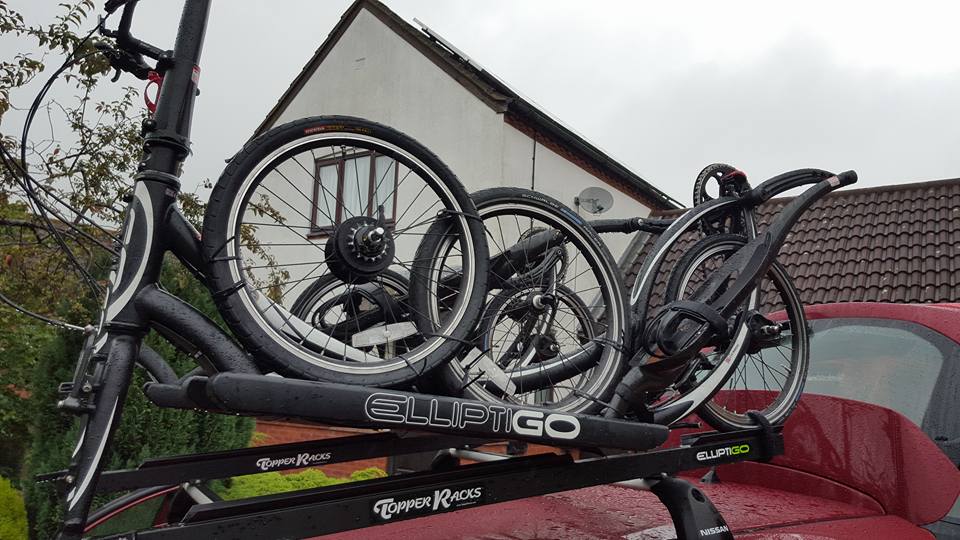
We had to use our ingenuity to pack the car for the PBP 2015 Trip!!! This solution was Ivy’s idea…
I must make it clear that my ‘obsession’ with extreme endurance sports training has not ‘blinded’ me to the realities of health & fitness in general – and my main driver in what I do in endurance sport is probably exploration. There’s nothing particularly healthy about taking on the types of endurance challenges I do, although I do believe that they can be successfully incorporated into one’s long term health strategy – as I’ve explained in the past. But I mainly want to know what’s possible for the human body and the human mind. The complete understanding of human physical performance – and the associated mentality required to optimise it – is what mainly interests me…
I do not particularly feel that what I have done in the past few years in endurance cycling is something that needs to be ‘rolled out’ or ‘built up’ in any big way. Nor do I feel that the participation levels in long-distance elliptical cycling particularly need to be increased. But I do feel that the knowledge base I am building with my growing number of ‘hard-core’ team mates is very important in the ‘science’ and ‘art’ that I am a part of – and that this information is crucially important for those individuals out there of a similar inclination to my own (people who have an irresistible urge to push themselves towards the absolute limits of what’s possible for their bodies).
Ultimately, that’s always what this has been about for me – it’s mainly about finding my limits and actually knowing when I have truly reached them. My training journey started when I was 7 or 8 years old (my exploration of my physical capabilities) and it has advanced relentlessly from that point until now (at 41 years old) when I have probably neared the peak of my understanding of how the human body works – and what that knowledge allows it to do.
I’ve noticed that some people enjoy playing Monopoly, others enjoy hiking in the countryside – and still others enjoy riding motorcycles – and so on… I happen to enjoy exercising – and I have found the topic to be quite fascinating all through my life. So here we are – at PBP 2015…
Why Paris Brest Paris 2015?
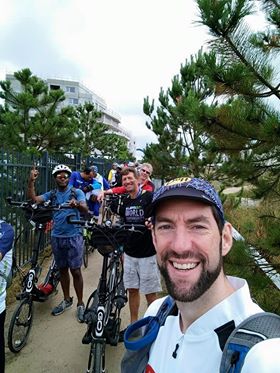
Hanging out with the team at the PBP 2015 Registration and Bike Inspection…
Paris Brest Paris – a 1,200km randonee cycling event with a time allowance of 90hrs – is possibly the oldest mass-participation endurance sports event in the world. It has been run regularly for well over a century, driven initially by a spirit of exploration of the absolute limitations of cycling equipment (and the absolute limits of the human condition). Some of the pioneering aspects have now been lost in an event so established, as we have become completely familiar with the capabilities of the equipment used and the methods for preparing human beings for such exploits, using that equipment.
But this ‘essence’ of the PBP challenge has not been lost on me – and having had the opportunity since 2010 to professionally explore the new frontier that’s elliptical biking, the concept of converging in Paris for PBP 2015 (and once again using the traditional challenge as a ‘proving ground’ for new equipment and new preparatory techniques) had started to make more and more sense to me, serving as a neat way of ‘wrapping up’ the knowledge base I’ve been working so hard to understand over these last few years – as well as a means of validating a couple of concepts (to myself, mainly).
There are many aspects to this training exploration I’ve embarked on – and science and curiosity were not the only drivers of this expedition. They were the main drivers of the exploration for me – but certainly not the only ones…
Preparation…
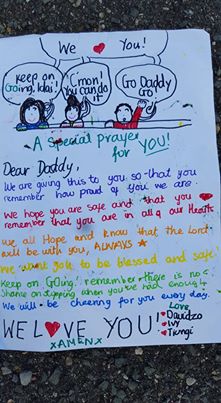
My Good Luck card from the children – very touching…
It had become clear during our preparations for the 2013 London Edinburgh London Audax – an event very similar to PBP 2015 – that there are a variety of methods for approaching a very long ElliptiGO ride. An optimisation of training volume and training intensity needs to be established – and it needs to match the personality of the rider being trained. Certain individuals cannot bear extremely long training sessions over the long term (purely from a psychological perspective, but sometimes simply for practical reasons around lifestyle and personal commitments). Others are almost at the opposite end of the spectrum – and simply cannot handle high intensity work over the long term.
So the first thing to establish when taking on a challenge like this is what type of athlete you are dealing with and what they actually LIKE doing. You cannot prepare well for an endurance event if you do not actually like/enjoy the training. There’s virtually no point in doing it if you cannot enjoy it for the majority of the time that you do it. So it is important to select the ‘right’ people for this type of challenge. I had fielded this ‘query’ to about 30 ElliptiGO athletes whom I knew – and whose physical abilities I was well aware of – especially targeting the most genetically talented individuals in my sphere of influence.
I had also targeted those individuals whom I already knew had a ‘need’ to take on challenges of this nature and whose mindset I was already familiar with (in relation to their passion and relentlessness for achieving physical goals, regardless of the perception anyone might have of their abilities). To cut a long story short, I have discovered, in the recruitment process of the ElliptiGO Ultra-Endurance Team, that the ‘athlete mindset’ is possibly more important than their physical credentials.
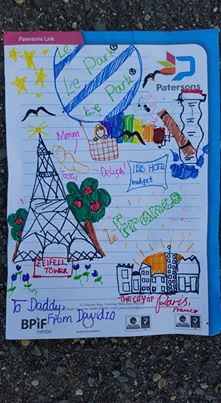
My daughter’s celebratory card, before the big Paris adventure…
I am now of the belief that the majority of the healthy population possesses the physical capability required to take on a massive endurance cycling challenge like the PBP – on any good standard bicycle – and that a good (but smaller) proportion of the ‘normal and healthy adult population’ also have the capability of doing so on an elliptical bike – if they can find the motivation to do so. On the elliptical bike physical ability is a must – no amount of mental strength and fortitude will allow you to meet the strict audax time limits in these sorts of events if your body is not physically capable of doing so (and there are definitely many people who have the right mindset, but lack the physicality required for this).
It’s become the buzz-phrase in endurance sports these days to say “it’s all mental”, or “it’s 90% mental and 10% physical”. It’s not really true at this level of being tested. You have to have a healthy dose of both. I look at it like you cannot live without your brain – and you also cannot live without your heart. So how do you say which organ is more important, when they are both ‘vital organs’? And for the endurance athlete (extending himself/herself at the level required to complete a multi-day audax event on an ElliptiGO), both mentality and physicality are ‘vital qualities’. You will not succeed without the correct balance of both qualities.
Training:
Our training strategies for long-distance cycling events on the ElliptiGO tend to range from high volume and low intensity, to high intensity and low volume. Because of the intensity of the training onslaught, the average ElliptiGO rider will train over considerably fewer miles than the average conventional cyclist (preparing for the same event). But I am now confident that the training approaches can be replicated on either machine and that ‘cycling training’ is probably more appropriate (for riding long distances on the ElliptiGO) than ‘running training’. By this, I refer to the volume and intensity approaches in the respective sports – as applied to training for very long duration events.
Most people who use elliptical bikes originate from a running background – and the elliptical bike is purposely designed to simulate running (without any impact on your joints). This origin of the training has led to difficulties related to what I call ‘cultural misunderstandings’. By this, I mean that the average runner is not well versed in cycling lore (and the direct transfer of the running culture to elliptical biking has made it much more challenging an exercise than it actually needs to be, for many people).
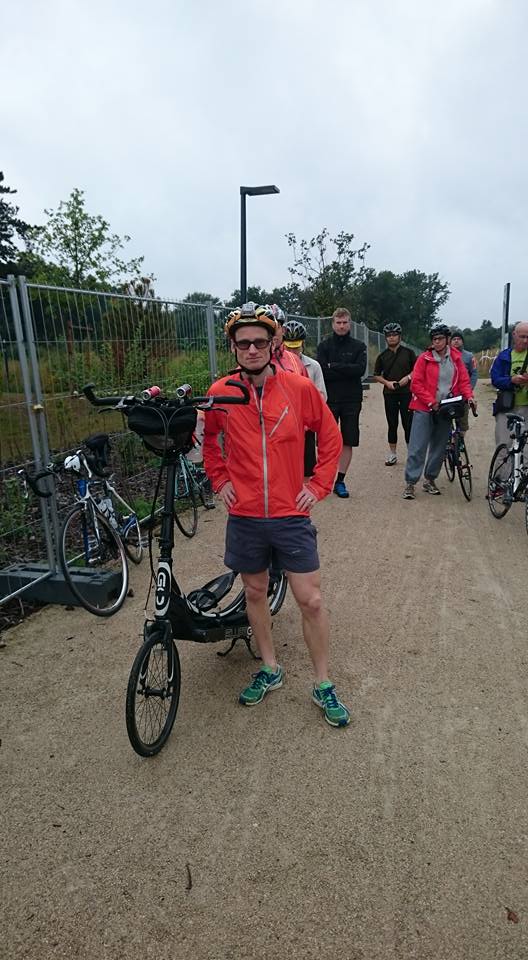
Billy looking relaxed at PBP 2015 Registration…
Training like a runner is hard – and gets you very fit. But that type of training is probably too hard to use to train for long-distance cycling events on an ElliptiGO. So one must learn to train as a long-distance cyclist if one is to successfully cover very long distances on an elliptical bike within the standard event time limits prevalent in long-distance cycling. The elliptical bike is inherently slow – and gives exceptionally diminished returns on extra effort when pace is demanded of it. This is fantastic for fitness training over reasonably short durations (and riding an elliptical bike with conventional cyclists, in a group, is probably the best 90-minute workout you’ll ever get). But this approach cannot be extended for higher volume training – and for days and days of riding.
The training approaches covered on this page probably tell you all you need to know about actual (mile-by-mile) training plans for audax events using an elliptical bike and I won’t clutter this article with the minor details of the training plans we used. Suffice it to say that 3 training sessions a week – ranging from rides 2hrs long to rides 6hrs long – will generally be sufficient to get most people into shape for rides of 1,000km (and further).
It is quite important during the peak training phase to ensure that all your ElliptiGO long-distance cycling training is carried out at an average pace of 14 mph – and above – because there’s a definite intensity ‘switch’ at 14 mph on the elliptical bike (at which point any extra effort is rewarded with very little extra pace). That is the zone to be in when you train – if you want to develop sustainable pace – and that’s also the zone to avoid during the events, if you want to sustain your pace indefinitely.
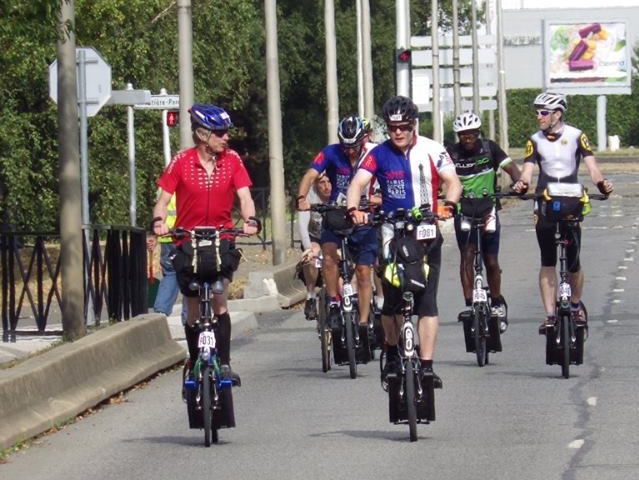
The ElliptiGO Team riding out of St Quentin at the start of PBP 2015 [16 August 2015].
Follow your heart – regardless of your perception of your ability – because the only way to know whether or not you can (or can’t) do something is to make an honest attempt at it. Some ElliptiGO riders have never measured up to the 14 mph ElliptiGO pace metric I’ve outlined above, but in many cases it is because they’ve never applied themselves appropriately to their training.
Scientific training is crucial for achieving your full abilities – especially in a demanding sporting discipline. People who train inappropriately often will never get anywhere near their true capabilities, because the main advantage of scientific training is the continuation of progress and the extrapolation of that improvement over very long periods.
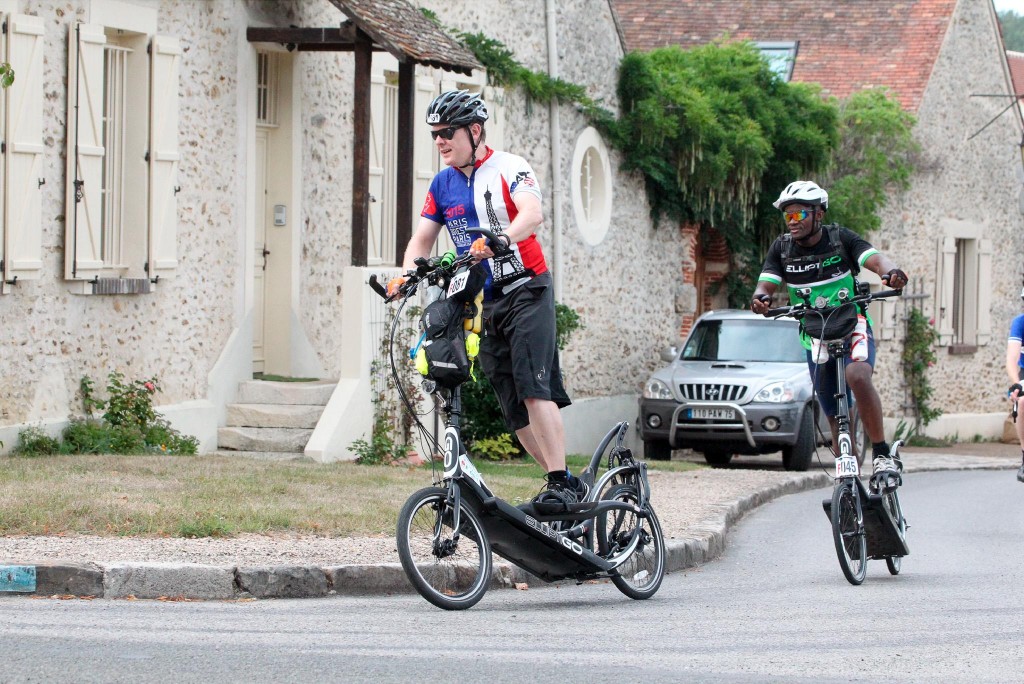
Bill and Idai: Enjoying the early stages of the journey…
Training correctly allows an almost linear improvement, over time. Poor training often still gives some noticeable initial results, but many people simply do not realise just how mediocre their longer-term performances might be (in relation to their absolute potential), if they do not fully explore training science and match it to their needs.
For me, personally, the only major change I have made in the 2015 training season (compared to previous years) was to ‘intensify’ my intermittent fasting (fasted endurance training) protocol, by spending at least 20 hours of every day fasting (and making sure that all my training coincided with the end of the fasting period). That means that the 20hr fasting period – and all my training rides – always ended at exactly the same time.
I won’t delve into too much detail on this aspect of my preparation, as it’s a very specialist area which should not be ‘dabbled in’ without a complete understanding of the methodology (and without experienced supervision). What I will say is that in previous years’ endurance training campaigns I had only fasted on my actual training days (and had mainly fasted for just my longer training rides).
This year, I fasted for 20hrs per day, 6-7 days per week, during my peak training phase (from about May 2015) – and I fasted during all my workouts (at all training intensities and across all training distances). The switch to daily fasting appears to have brought immediate changes to my energy levels and to my endurance capacity – as well as an optimisation of my power-to-weight ratio (through enhanced leanness).
I believe that one of the more obvious benefits of using intermittent fasting – and fasted endurance training – is related to the efficiency developed in my body’s energy processing systems during endurance performance (because the glycogen stores in the muscles increase tremendously when athletes regularly train in a fasted state – and their fat burning ability optimises as well).

ElliptiGO Team registration finally completed!!! [at St Quentin National Velodrome]…
Many people are unaware of just how harmful the insulin hormone is to the human body, despite it being an integral aspect of human physiology. I view insulin as a ‘necessary evil’ – a ‘poison’ which we must take in small doses in order to live. We must produce insulin to stop sugar from poisoning our blood every time we eat (because insulin forces glucose out of our bloodstream and into our muscles, where it can be stored – or used as energy). Exercise also has the same effect of ‘forcing’ glucose into your muscles (and can do so even in the absence of insulin – incidentally).
But the insulin and growth hormone production systems are incompatible in the human body – and whenever a large amount of insulin is produced, the body’s production of growth hormone is blocked for long periods. Fat cannot be burned easily when insulin is present in the bloodstream – so prolonged high insulin levels in the bloodstream will cause people to get fatter, simply because it stops growth hormone production (and that blockage of growth hormone production inhibits the fat burning metabolic pathway).
The inability to burn fat doesn’t only affect your total body weight and your health – it also limits your endurance performance (because one of your energy pathways is not fully accessible to fuel your physical activity).
The reason for this blockage of growth hormone production by insulin probably originates from the natural ‘design’ of all animals to sleep daily. Sleep is a period during which there’s no eating and, hence, no insulin is produced for quite a long time when you are asleep. So by ‘natural design’ there’s actually no need for insulin and growth hormone to be produced at the same time, because we eat while awake and recover and repair whilst asleep.
This gives sufficient time for spurts of growth hormone to take place, to revive the system and repair any damage, whilst also adapting to any exercise-related stress. In the natural world meals are not a ‘given’ – and animals will often hunt or forage for food over periods of many hours – and even many days – after waking from their sleep (giving even more time for potential release of growth hormone, during waking hours).
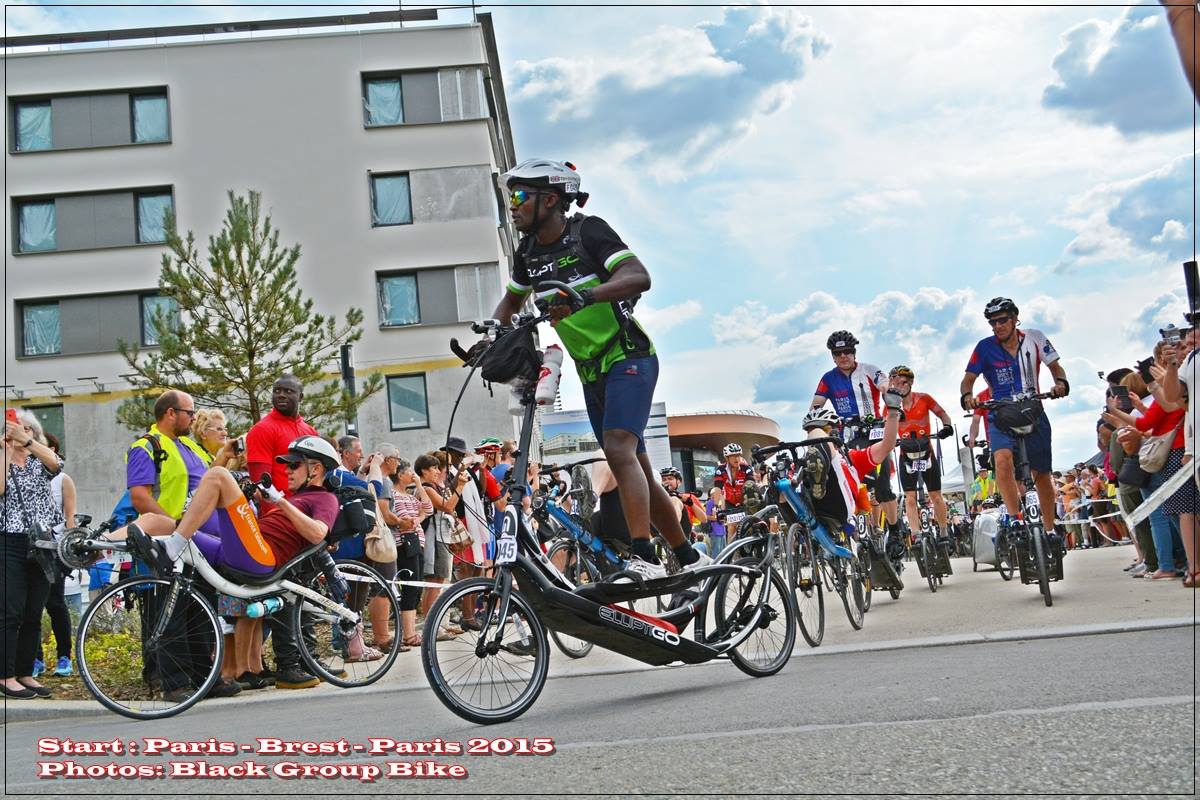
Hitting the Road at the start of PBP 2015…
So we are also designed to carry the fasting period from our sleep into our active day – whilst actively seeking new food sources – a biological pathway mainly disused in modern human societies (with immediate access to food at almost every waking moment) but still fully present in all of us, if exploited and trained.
This is where intermittent fasting really makes its mark for what I do, because I allow my body to potentially keep on producing the growth hormone spurts across a 20 hour period of every day (rather than just using the 6-8hrs spent sleeping). This prolonged absence of insulin production in my body has apparently had profound effects on my health and well being – and seems to have noticeably impacted on my physicality and mental acuity. Also, completing all my training in the fasted state (and at the end of a 20hr fasting period) allows for intensified fat burning during the actual period of exercise.
In measured terms, that’s (theoretically) 3 times as much time during which the most important exercise hormone can be produced in my body (and the most disruptive one can be ‘suppressed’). This ‘supposition’/theory cannot be measured medically – it is just a theoretical rationalisation – but the results on paper cannot be ignored. All the guys who ride (or train) with me could see the changes in my performance from May 2015 – and I have measured them myself in my training logs. Not only could I ride harder (and still feel completely refreshed shortly afterwards), but my general resilience and resistance to all types of fatigue was improved noticeably under the enhanced fasting regime that I took up this year.

The ‘festival’ of the start of PBP 2015 was quite a sight to behold…
I had soon realised that although I’m not exceptionally quick on the ElliptiGO, with the added resilience from having such extended periods of growth hormone production in my body, I could considerably transform my performances in ultra-distance events (like the PBP 2015 ride) without even having to actually ride any faster on the road. I believe this was because when I build up to my peak fitness in this way (using intermittent fasting and fasted training) I am able to subsist on very little sleep, food, or water.
So I believe I have reached this heightened level of fitness through many weeks of sustained, daily intermittent fasting – and the exclusive use of fasted training. Being able to stress myself more, for longer durations (and without sleep) is actually the perfect formula for a very good audax ride on a slow bike. PBP 2015 was a good opportunity for me to truly test this theory…
PBP 2015:
After starting out with an initial group of about 20 athletes, our ElliptiGO Ultra-Endurance Team had eventually ‘self-selected’ down to just 8 individuals (as we had progressed through the official qualification process for PBP 2015). So the Team ElliptiGO athletes who eventually lined up at the start of PBP 2015 were Alan McDonogh, Andrew Nuttall, Billy Grace, Bill Pinnell, Carl Nanton, Jim Cremer, Idai Makaya and Stuart Blofeld.
I’ll now outline my experiences at the PBP 2015 audax, from when I left home. Here GOes…
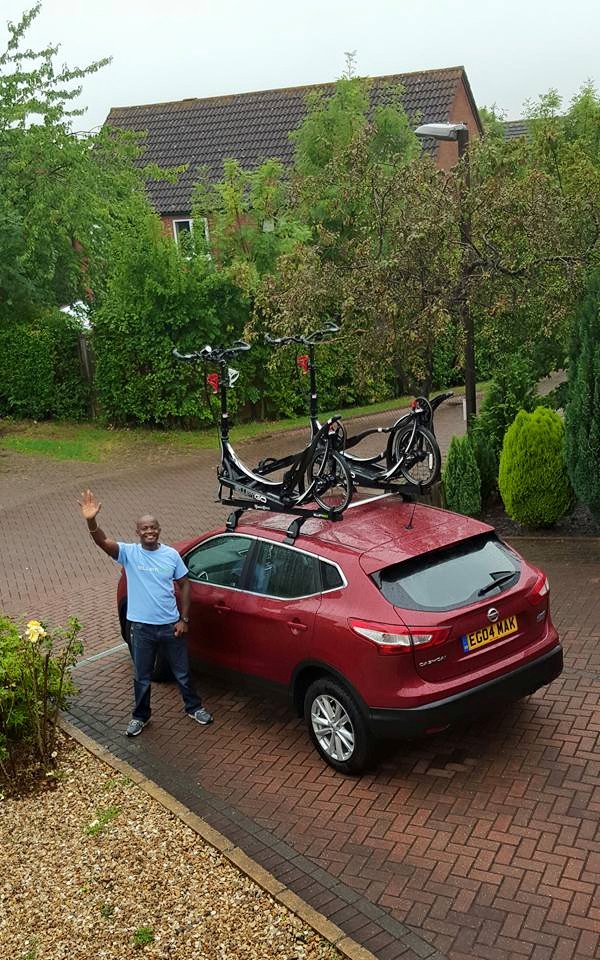
Leaving home for France, 14 Aug 2015…
14 Aug 2015: I travelled by car to St Quentin, with my whole family. I was like a caged greyhound and I found interacting with other people quite difficult on the trip – preferring to muse over what I was planning to do during the ride and rehearsing my ride over and over in my mind.
I had needed my family close by, but at the same time I did not want them to interfere with my ‘meditation’. Long drives are good because everyone tends to withdraw – eventually – and I was pretty much left to daydream as we drove along. Bad delays at the ports along the way – and very sad scenes with refugees at Calais – had blighted the trip for me, but we made it across the English Channel and into France…
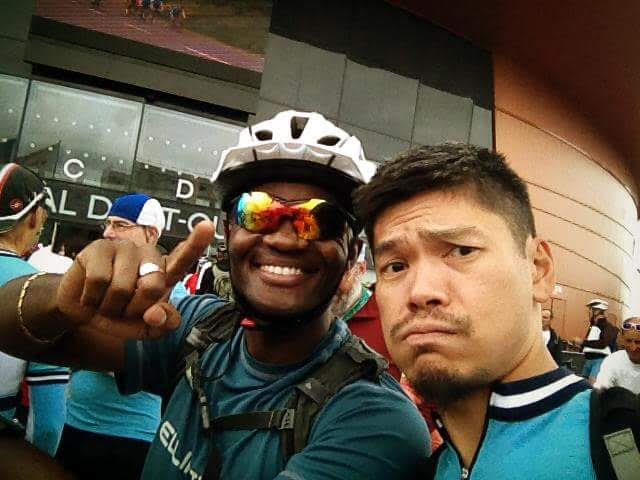
With my friend Patrick – after PBP 2015 registration [at St Quentin Velodrome]…
16 Aug 2015: It was a long wait for our 17:15 start time and I was bogged down in the logistics of changing hotel rooms for the family and making sure everyone would be okay while I was away riding. This was a distraction – and it definitely raised tensions – but it also helped keep me occupied throughout a whole day of ‘waiting’ for the event to finally start (so that I didn’t dwell overly on the task which lay ahead).
The ride had started promptly at 17:15 and we rode through throngs of local supporters as we had left St Quentin and headed into the Parisian countryside (see this video clip for a visual). There was a feeling of complete elation once we had got moving, after nearly a year of planning and about 8 months of formal training. I had kept on telling everyone how happy I was to be there – and I had really meant it! I can’t remember many a time when I have felt so upbeat – and my reasons for feeling that way are not completely clear to me, even now…
![The ElliptiGO Team In Full Flight on the first night of PBP 2015 [Image by Tim Decker]](http://idaimakaya.com/wp-content/uploads/2015/08/PBP-Team-In-Flight.jpg)
The ElliptiGO Team – in full flight – on the first night of PBP 2015… [Image by Tim Decker]
Carl’s gear shifter cable had slipped out (after he had swapped out his rear wheel on the day before). I was a little disappointed that Carl had done this job himself – when we actually had a professional mechanic (Grant Strong) supporting the team for the entire event and doing all the necessary servicing needed on our team’s bikes. But I knew it was ‘one of those things’ which cannot be foreseen (and he probably had felt worse about it than I had).
I was reluctant to ‘abandon’ Carl at that point – but he had the necessary equipment to replace the gear cable on his own and he had suggested that we all leave him to it on his own. Also, the team had (rightly) suggested that we continue to move on – in order to avoid holding up the ‘collective’ every time someone had experienced a setback. With our lack of pace on elliptical bikes, every stop would reduce the average pace – and that lack of pace could not be made up for by simply riding faster, later on.
I was surprised at a building discomfort in my feet – from pretty much the start of the ride – a suggestion that I was riding too fast. I am normally very good at remaining comfortable on my bike and sore feet are always the result of the cadence and power output being too high. Jim and Stu had seemed to be spot-on with their pacing at this early stage, so I had consciously decided to try and mirror what they were doing, which did help me get more comfortable. But once foot discomfort starts on a long ride it is unlikely to go away…

Carl Nanton overcame early setbacks to put in an inspirational ride at PBP 2015…
We had covered the first 76km in about 3.5hrs. Carl still hadn’t caught up by then and we had switched to our high visibility vests for the coming night ride. Our pace had remained even – and possibly still a little too fast – and we’d reached the first checkpoint (at 140km) in exactly 7hrs. At this point we’d realised just how disorganised we were as a large group and the control checkpoint was jam-packed, meaning access to food and drinks was difficult. We had lined up for food and Carl had eventually caught up with the group during this time – and then he promptly passed on ahead of us…
The night ride on that first night had been pleasant, but we’d noticed that the event had become very undulating from about 140km onwards. At the time I had thought this ‘hilly patch’ would be a small segment (and then the ride would flatten out again). However, it never did flatten out – and will go down as the hilliest event I’ve completed, to date…
17 Aug 2015:
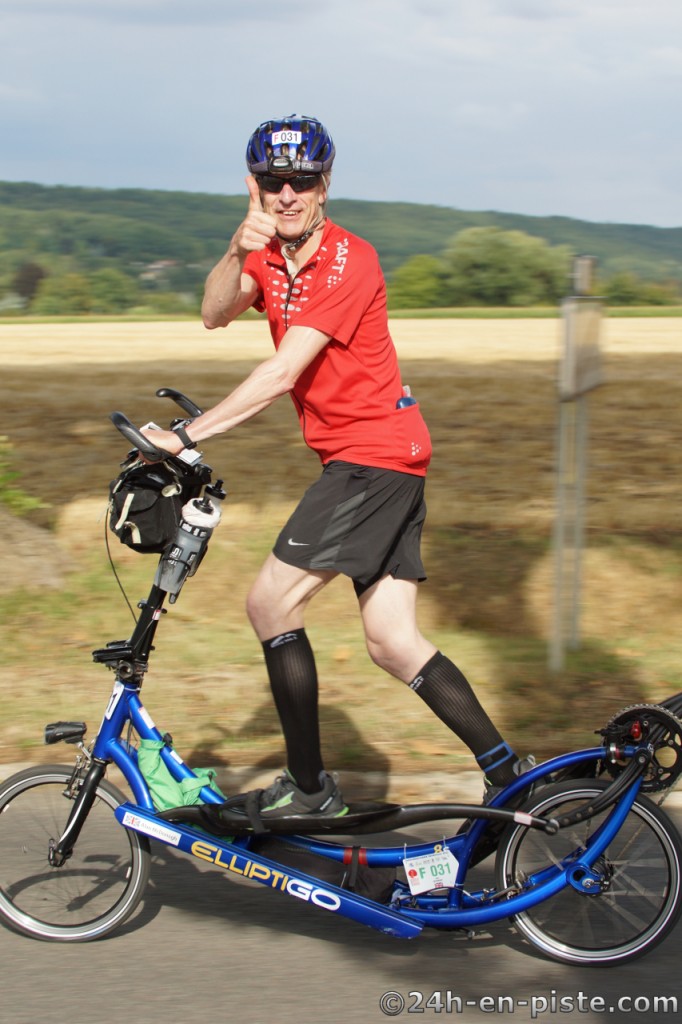
Alan McDonogh put in another strong ride to complete the LEL 2013 & PBP 2015 ‘Double’ – and has now completed both of Audax long-distance cycling’s premier international events…
We had reached 265km in 15hrs of riding – and it was morning once again. It was very misty that morning and we’d had to keep our lights on – using up extra battery power, in my case (because I do not use hub dynamo energy generation, which some in our team do use). The initial euphoria had now left me and it was just ‘serious graft’ from that point onwards.
I was not particularly ‘endeared’ to the ride at this point, finding the terrain quite slow GOing – but I did marvel at the perfection of the French road surfaces and the commitment of the fantastic local communities along the way to supporting this ride and raising the spirits of all the riders. I had vowed to acknowledge every spectator who had applauded or waved as we passed by – and that’s what I did for the full ride – although it had soon cost me my voice (which I lost on the second day of riding – meaning that I had to wave to people from then onwards, unable to speak properly)…
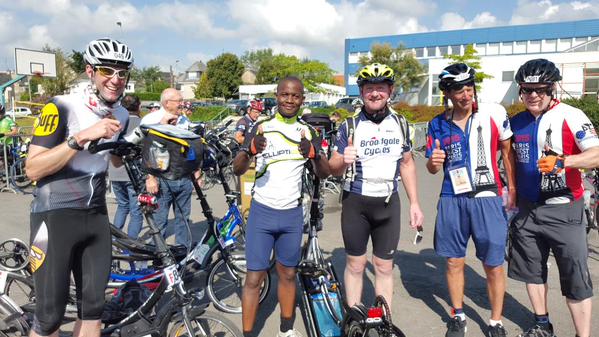
At Fougeres control checkpoint. The first 310km were covered in 18hrs, at PBP 2015…
We had covered the first 310km in exactly 18hrs, with no sign of Billy and Carl – who had advanced pretty far ahead by that point. It was not lost on me that riding over 300km in 18hrs is a decent (and normal) time for me to cover a 300km audax ride on the ElliptiGO – and that doing so on such a hilly course (in such a long event) may have been somewhat ‘careless’. The soles of my feet were getting painful as it got hillier and hotter during the day.
I was now ahead of what I had perceived to be 80hr finishing pace (using Billy’s positioning as my ‘guestimate’) and the time had come to make it clear to my team mates that I was exceeding my planned pacing objective and would not be sticking with them if the pace didn’t slow down. So I had let some of the faster guys pull ahead of me and was really only catching up with them at the control checkpoints from then onwards.
363km had been covered in 21hrs and 20min – and Jim was having bad gastric issues, unable to eat solid food and depleting his energy reserves as a result. This was slowly sapping his energy, but he’d somehow been able to continue at more or less the same pace as us, until that point. But after the 363km control point he’d started to fall behind the group pace and was even GOing too slowly for me.
Again we had reached a crisis decision point, as we’d done with Carl the day before. Bill had opted to stay back with Jim, feeling that the group pace was inappropriate, but I’d remained with Alan, Andy and Stuart – who had seemed to be getting faster and faster (perhaps I was just getting slower and slower, but that’s the way it had looked at the time). We had reached 450km in about 26hrs and I’d severed contact completely with Alan, Andy and Stu – opting to rejoin Bill and Jim temporarily. But they had wanted to stop a bit too often for my objectives at that stage, so I’d split from them too (after another long food break) and soon I was riding solo.
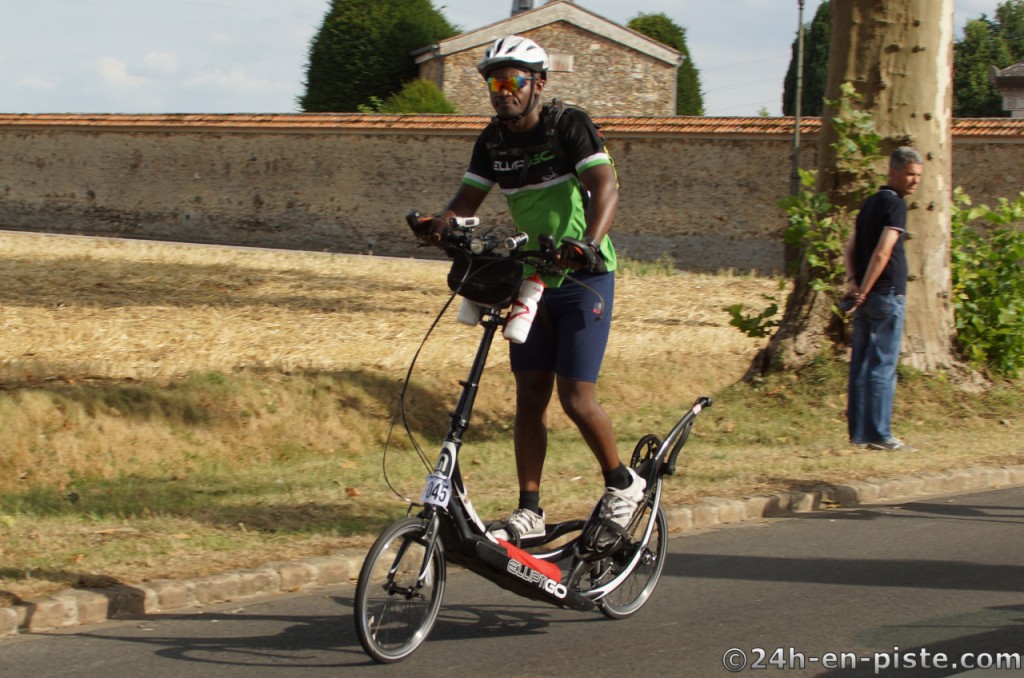
Idai Makaya – riding comfortably during the early parts of Paris Brest Paris 2015…
It wasn’t a bad thing being on my own – and away from the team. I quite enjoy riding on my own – and the streets were packed with cyclists and spectators, so being outside of Team ElliptiGO was really just a ‘pacing relief’ for me. I wasn’t lonely, or isolated, in any way. I was probably quite happy, under the circumstances. What did bother me a lot was the increasing heat…
We had caught up to Carl at around 450km – because he was becoming drowsy – as were Bill and Jim (who were still quite close behind me). So around this section I’d passed them all at the control checkpoint and had continued to press on into the night. This was where my enhanced resilience (from the fasted training) was becoming more evident, because all of the riders in the team were battling sleep deprivation at this stage – and I was still relatively fresh (in comparison)…
After a series of hill climbs in some very dark countryside we’d hit a main road where we were able to make decent progress for quite some time. It was around that time that someone had shouted out my name from the roadside and I’d spotted Carl retiring into a bus shelter with his bike, for a second nap (not long after leaving the control checkpoint where he’d also had a nap – so bad was the drowsiness). I’d looped back to meet him, despite busy traffic (hundreds of cyclists were on the same road at this point) and we’d shaken hands and exchanged greetings and reassurances.
Then I had left and found what was called a ‘secret control’ checkpoint – just 5 minutes further on. This was set up to ensure riders were following the official course – and also had served as a resting point. So I was saddened that I couldn’t tell Carl about it, as he was just a few minutes away, toughing things out in a roadside bus shelter…

496km were covered in 30hrs & 15 min. Here I’m pictured with my friend Nick (who was riding a folding bike) at the secret control at PBP 2015…
496km had taken me 30hrs and 15min to complete and at that control point I had found Alan, Andy and Stu’s bikes parked outside – and they were taking their first sleep break, inside. We’d all been awake for about 40 hrs by this point (since getting up in the morning of Sunday, 16 August, 2015). I’d become very aware of the sleep deprivation I was experiencing and was liaising with Grant at the support vehicle to plan my sleeping strategy. Grant was able to update me on how far ahead Billy was and I had noticed the gap closing, which had spurred me to ride on – knowing that Billy was on an 80hr finishing schedule.
18 August 2015: Fatigue had finally caught up to me around the very hilly section approaching halfway and I had taken my first attempt at a nap. The plan was to use Grant’s car every time I had needed to sleep, so that the naps could be exactly timed (and very short – without any disturbances). So I’d got into the passenger front seat, while Grant had tinkered with the bike and checked it over.

Daybreak… [Image by Ivo Miesen]
I had failed to fall asleep within the allocated 5 minutes and had then set off on the bike again, with just 15 minutes of sleep in the ‘sleep bank’ since Sunday morning. The ride had continued along a series of gradual climbs, known affectionately as “The Roc”. I had noticed that singing out loud was doing a brilliant job of keeping me alert and awake – and because there were fewer riders moving after midnight, I had not felt too self-conscious about doing it, despite my awful singing voice!
I find that singing heartfelt songs during long rides works well for me when I’m battling to remain awake, so for me that’s always love songs (which I actually will be imagining that I’m singing to my wife). How sweet…
Exactly which songs I choose is always completely random at the time – and generally beyond my control – because I can only ever think of 3 or 4 songs when faced with this type of challenge (and I am often forced to rotate through those 3 or 4 songs, almost indefinitely).
On this ride I was particularly hung up on Patrick Swayze’s theme song for the movie ‘Dirty Dancing’ – a track called “She’s like the wind…”, and Aretha Franklin’s classic: “Ever-Changing Times…” and Vanessa Williams’ and Brian McKnight’s less well known R & B hit: “Love Is…”
So I had sung each of those songs, in turn – over and over – for hours and hours. It had just felt more intense each time I sung each song – and it had more meaning each time. But my voice was gone and it really hurt my throat. I had felt that was a sacrifice I had to make at the time (I had to sing the songs out loud for it to work) and it did work, because I had reached Brest (half-way at 619km, as measured on my GPS device) in 39hrs and 15 min – feeling reasonably alert…
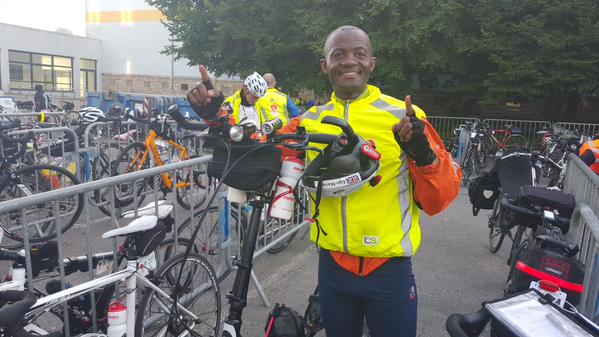
Reaching Brest (619km in 39hrs & 17 min) had felt like a triumph in itself. It’s unusual for me to celebrate any landmarks mid-way through an event, but on this occasion I had done so…
That was a real high point for me because everything was going according to plan, which is very rare for me in long rides. I had planned to take no more than 40 hrs to reach Brest and that goal had been accomplished, giving me a sense of control over the event – a sense of dominating the ‘Beast’ which I was trying to ‘tame’. So I became very emotional having hit that metric, which is unusual for me on a long ride. I normally only view the finish line as my goal when I ride in events like this, but reaching the half-way point in PBP 2015 had been a notable landmark for me.
I had also found Brest really pleasant, in terms of the design, size and architecture of the town – nothing as dreadful as previous riders of the PBP had led me to believe it was. It had looked like a nice town to me, the sort of place I could actually see myself visiting with my family – and not the “run down historical port” I had been told to expect…
I had a quick breakfast in Brest, chatting with friends from Essex – and then headed back up the other side of the big long climb which had delayed my arrival time in Brest on the way in. There was a huge amount of climbing to get out of Brest and into the countryside – and the morning had heated up quite dangerously, I’d thought. I was quite uplifted by seeing a good number of my cycling friends (who’d started later than us), all heading into Brest as I had headed away. I especially recall my friend Patrick flagging me down on one of the long hill climbs and stopping me to hand over a pair of his club pins, a gesture which had meant a lot to me.
I had met with Grant at 2pm outside the next control checkpoint (at Carhaix) – after a whole morning of climbing and descending the long slopes leading to that checkpoint (and exactly 12 hours after I’d taken my first 15-minute nap in the support vehicle, before heading towards Brest). Grant had oiled my bike chain and running gear and had also given me two energy gels – which I’d squirted into my mouth in quick succession. In hindsight, that was probably an error (using the two gels – not the bike oil!) and it had caused an insulin spike in my bloodstream, which tends to lead to a sudden dip in energy levels soon afterwards (which is pretty much what had happened next)…
Carhaix was 704km into the ride and it had taken me 45hrs and 20min to get there. The sun was shining at it’s menacing brightest by this point and the heat was slowing me down – probably coupled with the fatigue of having been awake for so long, with so little sleep…
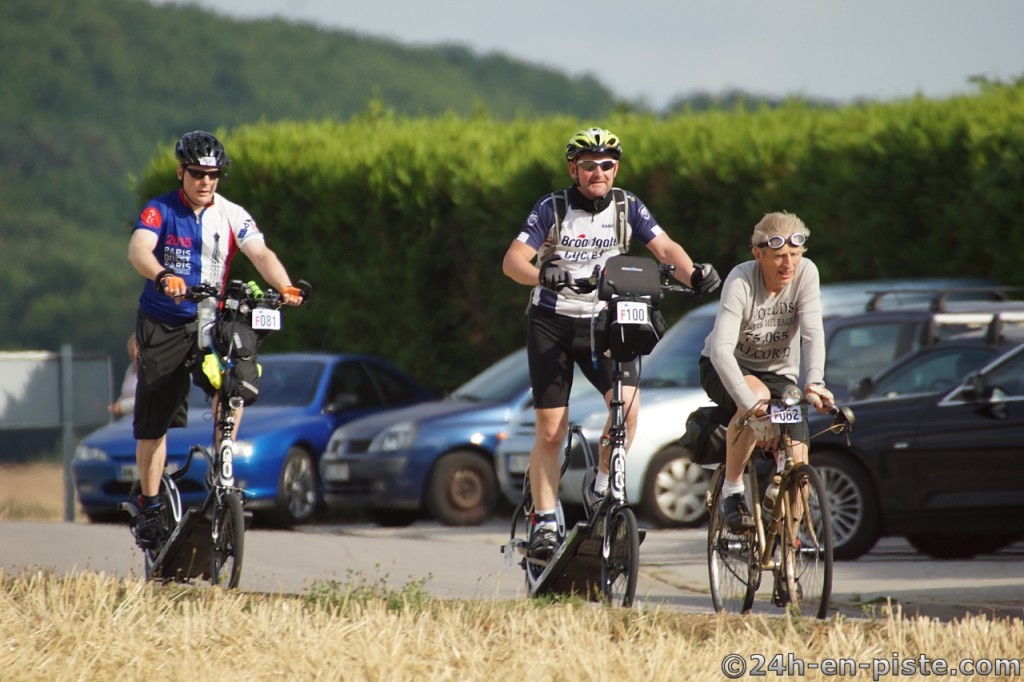
(L-R) Bill Pinnell, Andy Nuttall and Audax veteran cyclist Drew Buck – during PBP 2015…
I had continued on to the checkpoint at Loudeac, which was 780km into the ride. That had taken me about 50hrs of riding and we were reaching the end of the afternoon, hopefully ushering in slightly cooler conditions for night time riding. I had looked forward to the night sections of the ride, simply to avoid all the heat. But I did fear the drowsiness which would inevitably ‘attack’ during the night periods.
After 55hrs I had covered 839km and was becoming very drowsy again. I had found that slight rhythm changes had really helped me stay alert – such as toilet breaks, or food stops – anything to get me out of the hypnotic rhythm of simply riding and riding. This was especially important when the roads were crowded (because my bad singing had made me feel quite self-conscious in crowded places)…
19 August 2015: I was somehow able to push through another night without falling asleep but I did start to cross into the ‘danger zone’ as I call it. I was now so far ahead of our team that I could not properly liaise with Grant and the support vehicle. So I could not find a place to sleep. I had tried roadside naps, but was terrified of animals foraging in the bushes – or I got badly pricked by sharp nettles and weird grasses. So I had eventually decided that meeting Grant again was my only hope of getting proper sleep.
But I was very drowsy. An Irish rider had shared some caffeine tablets with me, which had kept me moving, but I had slowed to a crawl and was losing mental awareness. Billy overtook me at this point, although I wasn’t aware of it at the time (and neither was he – so we now believe he probably passed me just as I was lying down by the roadside, when I had thought I heard an ElliptiGO pass by me, but I was too drowsy to make it out properly in the dark).
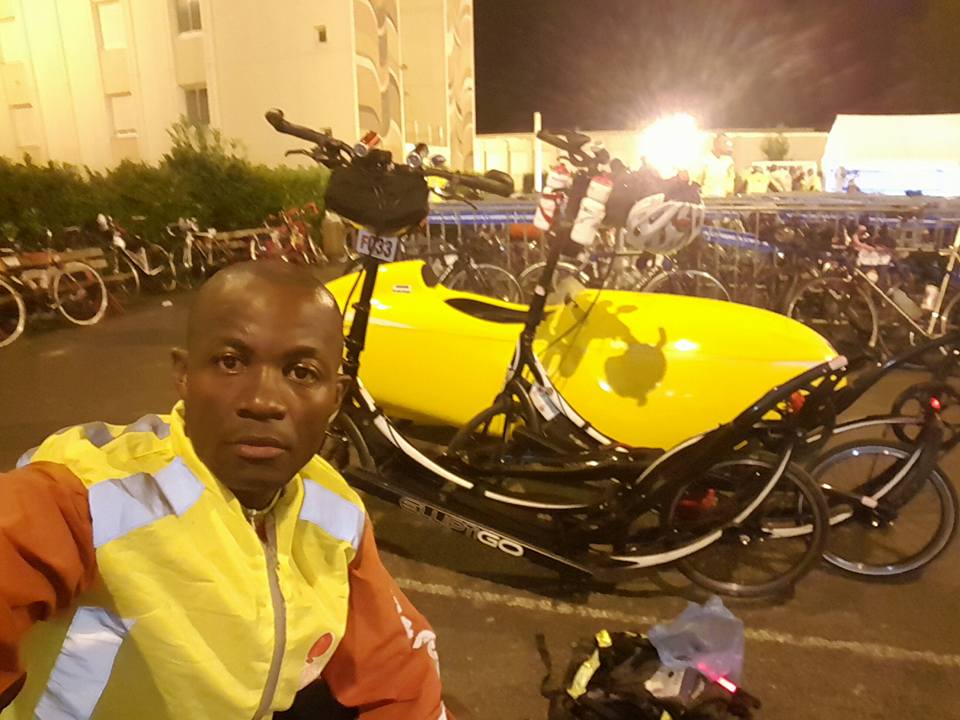
I’d found Billy’s bike at the Tinteniac service point – after 839km of riding (across 55 hours) – but I could not find Billy in person…
The next phase of riding is something I must acknowledge – although it is also something which I am not proud of – and I think it is only the disoriented state I was in that had allowed me to do something this irresponsible in the first place.
I had become completely unaware of who I was, or what I was doing. I often didn’t even know I was riding a bike. I was just dreaming – whilst still on my feet – and I often thought that I was watching somebody else (and not being myself, so to speak). I had lost all ‘contact’ with my body and could no longer feel, or sense, my own physical presence. It was pretty much an ‘out of body’ experience…
I often couldn’t remember I was actually doing PBP 2015 – the event I had thought about daily for 8 months, while training and preparing. At times I didn’t even know I was riding at all, I had thought I was just flying – or even just walking. It is the most surreal experience I’ve had so far on a bike – and during this period I would only be ‘jolted’ back to consciousness when I had completely fallen asleep (and had let the bike roll off the tarmac road and into the bumpy roadside grass). Miraculously, I never actually fell off the bike – or hit into anything – during those ‘dissociated’ phases…
It appears that some other people could see what was going on, because a guy from the Philippines (called Redg) had decided to stick around and ‘chaperone’ me to the next checkpoint. He was pretty tired himself, but I do still think it was quite difficult for him to move so slowly on a road bike. He’d obviously realised he was dealing with a guy of diminished reasoning and he could probably see the danger I was in – so he had tactfully struck up conversations and tried to keep me awake for the next few hours. I’ll never forget what Redg did for me…
Whenever I did regain some minor (fleeting) consciousness, it was only to get sufficient clarity to remember that I had still wanted to ride PBP 2015 in under 84hrs. I was completely committed to that time goal (and was actually adjusting my expectations – and looking towards attempting 80hrs, like Billy had been doing). So my goal then became to catch up with Billy again, which I had done at one of the non-mandatory checkpoints (the Tinteniac rest stop).
I had seen Billy’s bike parked there, but I could not find the man himself – and had left without exchanging pleasantries. At that point I had thought we could actually help each other to stay awake, so I was quite keen to find Billy – but not at the expense of losing more time – so I had ridden away (half asleep), back into the night…
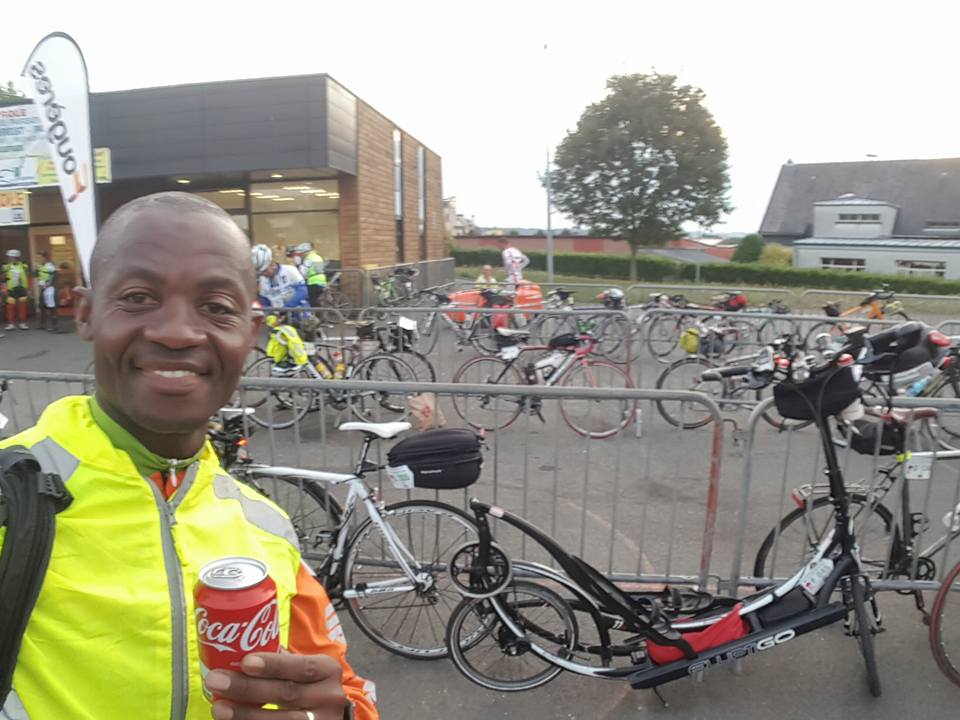
I was desperate to reach the Fougeres control checkpoint at 925km (which had taken me 61 hrs & 46min) – and I was using any caffeinated substances I could find to keep me GOing…
Thankfully, I’d found Grant at the next control checkpoint (Fougeres). I was now unable to continue riding. My feet were terribly painful – and I had virtually lost all meaningful consciousness. We’d agreed to a 30-minute turnaround for the sleep stop that morning (I had wanted less time, but Grant had looked very concerned and we had reached a compromise – based on his reasoning that I needed a 10-minute ‘settling down’ period before each sleep could be timed).
After he woke me up – and plied me with jelly babies – I had bid Grant farewell and had set off into the sunny morning, after 20 minutes of sleep. I had felt completely revived and was alert, reasonable – and able to focus on my plans again. I was confident I could break 80hrs for the full ride and was fully committed to this new and revised goal time. I’d had lots of British friends with me in this segment of the ride, which had made for a very pleasant morning, under the circumstances.
My riding ‘methods’ had changed about 450km into in the first half of the event, in order to stay on course for a fast time. Initially, when I was still riding with the ElliptiGO Team, I was using the control checkpoint facilities to get all my food (mainly French-style baguettes). But the service levels at the checkpoints were inadequate for my needs – with long queues and generally slow service. The food was also very ‘bland’, with most of the bread being so hard that it had lacerated my mouth badly – making all my eating quite painful for the rest of the ride.
So I’d decided to forego trying to eat more varied meals and had instead bought a bag full of the sponsored snack bars which were on sale at every checkpoint. My strategy was then focused on remaining in constant motion – at a comfortable and sustainable speed – whilst doing all my eating on the bike (on the move). So my snack bars were loaded into my handlebar bag, where I could easily access them as I rode. The checkpoints then became simply about ride validation for me – and getting my brevet card stamped – or stopping for cat-naps in Grant’s car.
Using this strategy, I was able to get through many of the checkpoints in well under 10 minutes (often taking just 8 minutes to get through each checkpoint). Even the checkpoints where I’d done my sleep stops in the car were taking me less than 45 minutes to turn around – and that had pretty much sustained my average pace, as I had progressed through the long ride.
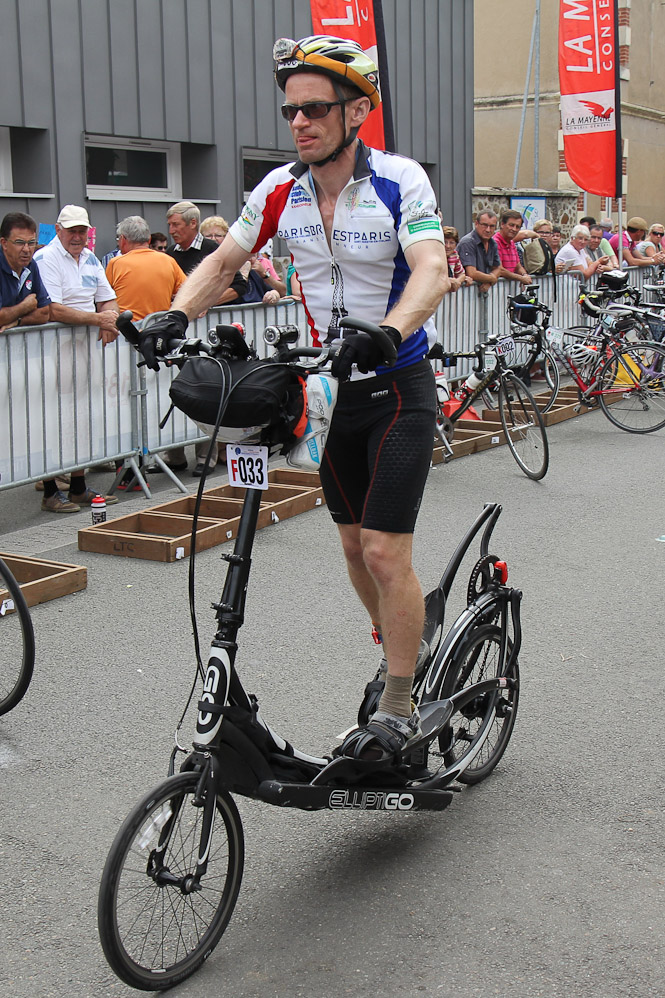
Billy in action at PBP 2015…
Later on, as I had approached 1,000km of riding, the day had seriously heated up again and the climbs were seemingly unending (in both number and duration). Inevitably, sleep deprivation had caught up with me again – and I was very drowsy from around lunchtime. This time around, I was definitely more alert than in my previous bout of sleep deprivation – but physically I was much more affected – and I was riding ridiculously slowly at that point. But I knew that as long as I was moving (and could remain awake and alert – in other words: “safe”) I was still getting closer to the end of the event (and getting closer to meeting my objective).
Another ‘guardian angel’ was sent my way at this point – this time in the large and looming shape of a former CTC Milton Keynes riding club-mate of mine, called Ritchie. Ritchie is as experienced and hard-core a long-distance cyclist as you will ever meet – and he was aiming for a sub-80 hour time in this event. Having started in a much later wave of riders than myself he was well ahead of his plan when we had met. He had realised just how dangerous I was becoming and had taken it upon himself to ‘shepherd’ me to the next checkpoint (and he made it clear I would have to take a mandatory nap there).
The course was brutal by this stage – with many long hills – and I had spent the rest of the day riding with Ritchie (who must have been incredibly patient to hang around like that, when I was moving so slowly). In fact, the whirring sound his bike made every time he stopped pedalling would jolt me back to my senses – each time my consciousness had drifted from me – and he was barely pedalling at all during this time (just trying to stick behind me and monitor me, so that I would remain riding in a straight line)…
1,010km had unfolded after 68.5hrs of riding and we’d ridden together for many hours until we had finally reached the next control checkpoint at Mortagne (1,090km – covered in 74hrs and 7min). At the checkpoint I had insisted that Ritchie press on without me, because Grant was there (with the car ready for me to sleep in). I’d had a quick meal (a very large hot dog) and I did 20 minutes of sleeping in the support car’s front passenger seat.
Billy was at the checkpoint when I got up 20 minutes later. I was feeling physically exhausted – but mentally rejuvenated – and I only knew Billy was there because Grant had told me so (and then I had seen Billy’s bike parked near mine, as I had headed out). Again, there was no sign of the actual man – so I had bid Ritchie farewell and set off once again without seeing Billy.
After about 10 minutes of pedalling I was feeling perfect once again! The next phase had longer and more rolling hills – and the descents were incredibly fast. I was virtually back to normal – with no foot discomfort and no tiredness – feeling fully alert and able to ride fast, once again.

Crowds would gather around the elliptical bike at every stop – but they were respectful never to touch it – and not to disrupt my progress…
I was moving really well from this point, despite the big hills, in unending succession. Between some of the controls a number of cyclists – myself included – were setting up incredible surges of pace (which would sometimes see us travelling at impressive speeds, over very long periods of time). The settings (and the faster pace) were allowing me to feel really upbeat – and to remain alert.
20 August 2015: Reaching the penultimate control (45 minutes after midnight, on 20 August, 2015) was like being in a bike race, with riders scrambling through the busy urban streets and trying to overtake every set of bike lights that had appeared on the horizon ahead of us. The excitement of approaching the finish had started to build up – even though we actually had over 100km still left to ride…
I’d met a succession of British riders, with whom I’d spent quite a bit of time chatting – despite my painful throat and hoarse voice – because those conversations had kept me alert as I was riding. The French riders were also very supportive and would often just ride beside me for long spells – even though we were unable to converse (because we didn’t speak each other’s languages – and I had lost my voice, anyway).
The decency and humanity I’d encountered during this almost inhuman challenge we’d taken on will remain with me for the rest of my life. The true inner decency of people is clear to see in an undertaking of such brutal honesty.
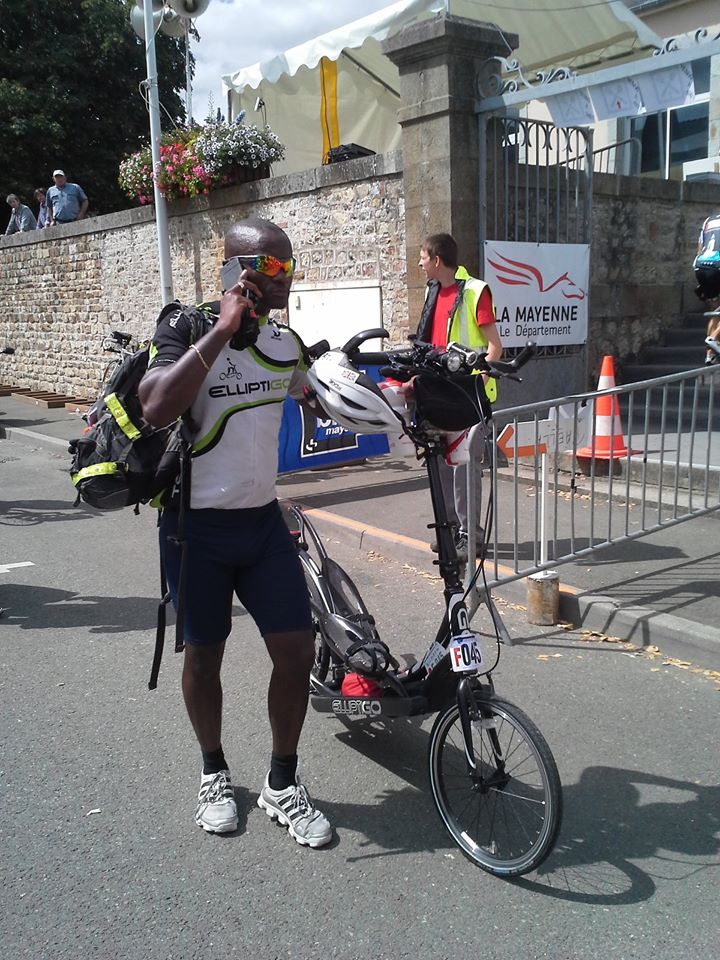
At every checkpoint I’d be sure to call Grant and to call Ivy and the children – to give them updates or to plan meetings with the support vehicle. [Image by Nicole Poisson].
Jim had pulled out of PBP 2015 at Carhaix control (703km) – due to his mounting gastric issues, which had meant he could not eat any solid food. Andy had later withdrawn from the event at Villaines control (after covering 1,009km) due to an acute back injury flaring up. It was an injury which Andy had actually incurred just a few days before PBP 2015, while lifting his bike and putting it into the car (to begin his trip to this event). But the rest of us were steadily pushing on at this stage – and our success had seemed to be inevitable.
I had also thought about my wife and children – and my brothers and sisters – and my parents. I had realised just how much I love my family. I was grateful to God for allowing me the privilege of challenging myself in this way – and for also surrounding me with the right people in my life. I had incredible respect for everyone who was doing the PBP 2015 challenge alongside our ElliptiGO Team – and for everyone supporting us. I was in a ‘good place’ at that point – and had rolled into the Parisian suburbs feeling completely alert – and feeling upbeat.
I had prayed many times during the ride – because that also helps me keep alert – and it makes the experience more spiritual for me (which is why I like to be alone for reasonable periods during very long rides). In my mind, I’m never alone, because God is always with me – as are all the people I love (who remain in my heart, wherever I GO).
The final 2-3 hrs of the PBP 2015 ride were uneventful – and quite boring, really. The terrain was very ‘urban’. It was very dark there, as well as very hilly. So I had just counted down the kilometres (painstakingly) until I had finally entered the National Velodrome in St Quentin, at 4:55am on 20 August 2015 (83hrs and 38mins after I had left it with my team, hundreds of my cycling friends – and about 6,000 riders in total).
I had only slept for a total of 55 minutes, across the entire PBP 2015 ride (comprised of 15 minutes on Day 2, then 20 minutes on Day 3 – and another 20 minutes on Day 4). This almost constant movement had allowed me to sustain a very good overall pace. I strongly believe that my unusual resilience in the face of sleep deprivation – and my lack of physical fade – had both related directly to my enhanced and sustained intermittent fasting campaign, over the months building up to the event.
My post-event recovery, so far, has also been quite remarkable (and writing this report on the day after completion of PBP 2015, I do not feel like I have ridden almost non-stop for 4 days – on an ElliptiGO bike – only finishing a day ago). I feel just as I did after completing my 600km qualifier at the end of May 2015 – well spent, but expecting a swift and complete recovery in the next few days.
A detailed log of my progress (with my times at all the checkpoints) can be seen in the table at the end of this report (below) – copied directly from the PBP 2015 website and timing system. Complete reports on the qualification and progress of our whole team, leading up to (and including) PBP 2015, can also be read on our team news blog.
[5 September 2015 Update] Idai’s film of this epic ride can be viewed using the link below:
To summarise, 8 of us from the team had started PBP 2015 on ElliptiGO bikes and 6 of us had finished the event within the 90hrs allocated. All 8 riders have a lot to be proud of and I am honoured to be associated with these individuals.
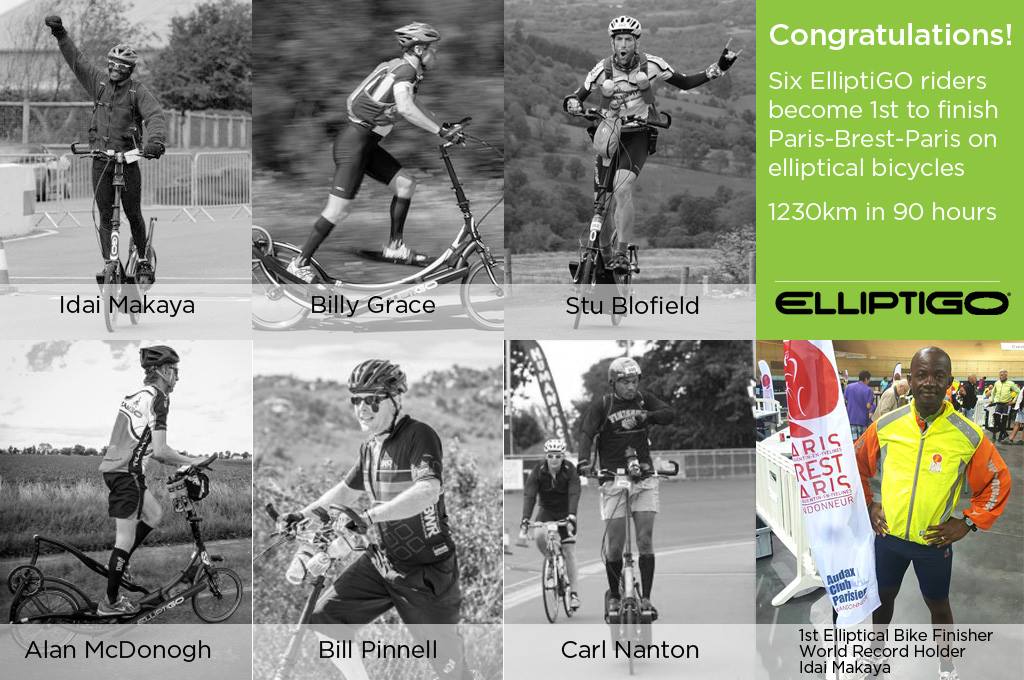
The picture mural put together by ElliptiGO H.Q. to celebrate our completion of PBP 2015…
My PBP 2015 Results Spreadsheet (with checkpoint times and pace readings):
The results below were copied directly off the PBP 2015 website and show the names of the control checkpoints (in sequence), the total distance covered (up to each checkpoint), my arrival time & date at each checkpoint, my average pace (measured only from the previous checkpoint) – and, finally, my overall average pace for the entire ride (up to each sequential checkpoint).
| Contrôle | Km | Temps | Passage | Moyenne tronçon | Moyenne Totale |
| START | 0 | 16/08 17:17 | |||
| VILLAINES | 221 | 12:15 | 17/08 05:32 | 18 km/h | 18 km/h |
| FOUGERES | 310 | 18:00 | 17/08 11:17 | 15.4 km/h | 17.2 km/h |
| TINTENIAC | 364 | 21:17 | 17/08 14:34 | 16.4 km/h | 17.1 km/h |
| LOUDEAC | 449 | 27:09 | 17/08 20:26 | 14.4 km/h | 16.5 km/h |
| CARHAIX | 525 | 32:52 | 18/08 02:09 | 13.2 km/h | 15.9 km/h |
| BREST | 618 | 39:17 | 18/08 08:34 | 14.4 km/h | 15.7 km/h |
| CARHAIX | 703 | 45:23 | 18/08 14:40 | 13.9 km/h | 15.4 km/h |
| LOUDEAC | 782 | 51:06 | 18/08 20:23 | 13.8 km/h | 15.3 km/h |
| TINTENIAC | |||||
| FOUGERES | 921 | 61:46 | 19/08 07:03 | ||
| VILLAINES | 1009 | 68:36 | 19/08 13:53 | 12.8 km/h | 14.7 km/h |
| MORTAGNE | 1090 | 74:07 | 19/08 19:24 | 14.6 km/h | 14.7 km/h |
| DREUX | 1165 | 79:29 | 20/08 00:46 | 13.9 km/h | 14.6 km/h |
| FINISH | 1230 | 83:38 | 20/08 04:55 | 15.6 km/h | 14.7 km/h |
